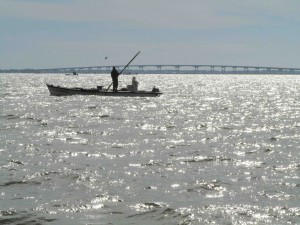By BRUCE RITCHIE
FLORIDAENVIRONMENTS.COM
Agriculture Commissioner Adam Putnam on Friday offered support for state wildlife officials as they whether decide to close Apalachicola Bay to oyster harvesting.

Alabama, Florida and Georgia have been fighting in federal court over water in the Apalachicola-Chattahoochee-Flint river system since 1990. Last Oct. 1, Florida asked the U. S. Supreme Court to step in because the state said Georgia’s water use was reducing flow needed for oysters and hurting the bay’s seafood industry.
Last week, Florida Fish and Wildlife Conservation Commission Executive Director Nick Wiley said the bay may have to be closed because the lack of oysters “is worse — worse than ever.” On Sept. 1, the commission sharply reduced the daily oyster harvest as seafood workers warned that overfishing still could occur.
Also Friday, Franklin County seafood workers met in Apalachicola and angrily voiced opposition to closing the bay, according to WCTV in Tallahassee. Shannon Hartsfield, president of the Franklin County Seafood Workers Association, said he was resigning — but he later said the action was premature.
Asked whether he would support the commission if it orders a closure, Putnam said the agency has some of the best biologists in the state and would not consider such a move lightly.
“If that is the conclusion they come to, then all of us across state government need to be prepared to move in and assist those families who will be devastated if that is the conclusion they come to,” Putnam said.
He made the comments to reporters while at a Lowe’s store promoting a sales tax holiday weekend on energy and water-saving devices.
Earlier this month, the fish and wildlife commission reduced the amount of oysters that can be harvested commercially this winter from 20 bags daily to five. Each bag holds 10 gallons of oysters in their shells.
The East Hole harvesting area will remain closed and some areas where shells recently were placed on the bottom also will be closed once they are identified, state wildlife officials said.
At a meeting of seafood workers and dealers in Apalachicola on Aug. 28, Hartsfield warned that oyster harvesting will become concentrated at Cat Point, one of the last remaining harvesting areas.
“I agree with doing something, but I think we’re going to destroy Cat Point,” Hartsfield said.

Last week, Wiley told a commission meeting in Central Florida that his agency was closely monitoring the harvest.
“But it’s very likely we’re going to have to entertain a complete closure of the Apalachciola oyster harvest,” he said. “We want to take that very carefully and only do that if everybody feels like that’s what we have to do.”
Earlier this week, Florida and federal scientists said there had been normal flows in the river system during the past month and that salinity levels in Apalachicola Bay were around normal. Conditions overall are improved compared to 2012, when Florida officials said continued drought and upstream water use had caused the oyster population to collapse.
On Friday, Putnam told reporters that the bay needs sustained freshwater flows, not just surges of fresh water from big rain storms. Until there are sustained flows, he said the bay may need to be closed so the oyster population can recover.
“Our folks, their (wildlife commission) biologists, a whole host of some of the brightest minds in the country from aquaculture are working on this,” Putnam said. “But it’s a race against the clock to save the livelihoods of those folks in Franklin County.”
The University of Florida Oyster Recovery Team on Oct. 1 will hold a listening session in Apalachicola on the situation. A follow-up meeting will be scheduled for presentations on the status of oysters, a bay management plan being developed by the state and other issues including funding to support oyster recovery.
(Story and photos copyrighted by Bruce Ritchie and Floridaenvironments.com. Do not copy or redistribute without permission, which can be obtained from bruceBritchie@gmail.com)
